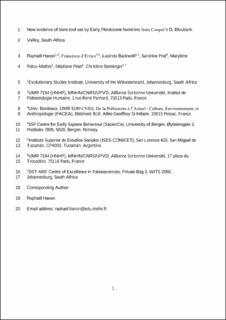New evidence of bone tool use by Early Pleistocene hominins from Cooper’s D, Bloubank Valley, South Africa
Hanon, Raphael; d'Errico, Francesco; Backwell, Lucinda R.; Prat, Sandrine; Pean, S; Pathou-Mathis, M
Journal article, Peer reviewed
Accepted version
Permanent lenke
https://hdl.handle.net/11250/2986561Utgivelsesdato
2021Metadata
Vis full innførselSamlinger
Originalversjon
Journal of Archaeological Science: Reports. 2021, 39, 103129. 10.1016/j.jasrep.2021.103129Sammendrag
Bone tool-use by Early Pleistocene hominins is at the centre of debates in human evolution. It is especially the case in South Africa, where 102 bone tools have been described from four Early Stone Age archaeological sites, which have yielded Oldowan and possibly Acheulean artefacts, as well as Paranthropus robustus and early Homo remains. Here we describe a bone tool from Cooper’s D. The deposit, dated between 1.4 and 1.0 Ma, has yielded seven P. robustus remains and 50 stone artefacts. Our results highlight similarities in morphology and use-wear patterns between the Cooper’s D bone tool and those previously identified at nearby Sterkfontein, Swartkrans, Kromdraai and Drimolen. Our findings increase the number of Early Stone Age bone tools and provide further evidence of their association with P. robustus. They suggest P. robustus had the cognitive capacities to develop this cultural adaptation and the manipulative abilities to implement it.

